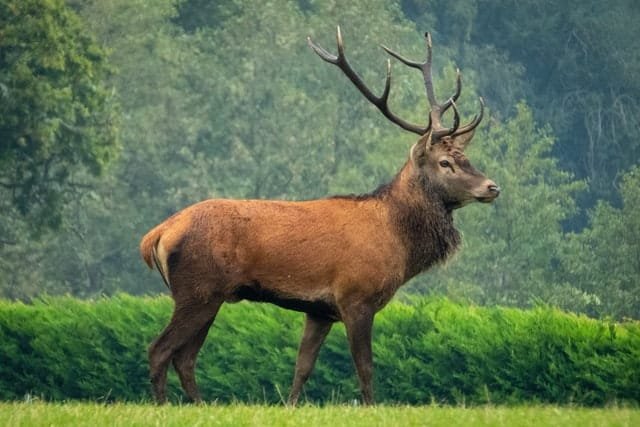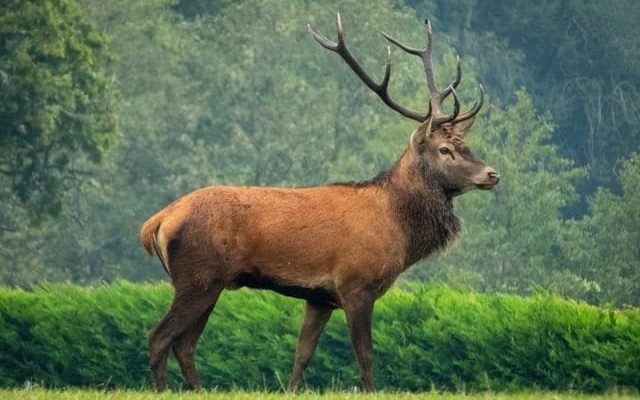
As we find ourselves more intrigued by the natural world, learning about red deer can offer insights into wildlife conservation and the ecosystems we share. So, let’s dive into some of the most interesting facts about these remarkable animals, exploring everything from their social structures to their unique adaptations. Grab a cup of coffee, and let’s enjoy this journey through the life of the red deer.
1. The Size and Appearance of Red Deer
Red deer are the second-largest species of deer in the world, only behind the moose. Males, known as stags, can weigh up to 250 kg (550 lbs) and stand about 1.2 meters (4 ft) tall at the shoulder. Females, or hinds, are generally smaller, weighing around 120 kg (265 lbs). The most striking feature of the stag is its impressive antlers, which can grow to be over a meter long. These antlers are shed and regrown each year, a process that is both fascinating and crucial for their mating rituals.
Here’s the thing: the stunning reddish-brown coat of red deer helps them blend into their surroundings, providing excellent camouflage against potential predators. In the winter, their fur can turn a darker, almost grayish color, which helps keep them warm during colder months. So, if you ever spot one in the wild, appreciate not just its size but how it seamlessly integrates into the landscape.
2. Social Structure and Behavior
You might be wondering what life is like in a red deer herd. These animals are quite social and typically live in groups that consist of hinds and their young calves. During the mating season, known as the rut, stags will compete for dominance and the chance to mate. This competition can be fierce, often featuring impressive displays of strength, including antler clashes that can be dramatic and thrilling to witness.
Interestingly, red deer are quite vocal animals. They communicate using a variety of sounds, from bellowing during the rut to softer calls for communication within their groups. These sounds not only convey their presence to each other but also serve as a way to establish territory. It’s a bit like a dog barking to let you know it’s around, but much grander in scale!
3. Habitat and Distribution
Red deer are versatile creatures and can thrive in various habitats. You’ll primarily find them in forests, grasslands, and even in mountain regions. Their preference for these types of environments allows them to feed on a diverse diet consisting of grasses, leaves, and shrubs. They require ample space to roam and forage, which is essential for their overall health.
A fascinating aspect of red deer is their adaptability. They are capable of living in different climates, from the temperate woodlands of Europe to the rugged highlands of Scotland. This adaptability helps them withstand changes in habitat and food availability, which is crucial for their survival.
4. The Importance of Antlers
Antlers are more than just a display of power for red deer; they’re essential for survival and reproduction. Growing primarily during spring and summer, antlers are made of bone and covered with a soft, vascular skin known as velvet. This velvet provides nutrients and blood flow as the antlers grow. Once the rut begins, the antlers become free of velvet, displaying their full glory.
During the rut, stags use their antlers to establish dominance and impress females. Antler size and health can indicate a stag’s overall fitness, making them a key factor in mating success. It’s like a peacock showing off its feathers, but in this case, size and strength speak volumes. The winner of these battles often gains exclusive mating rights, ensuring the continuation of strong genetic traits.
5. Diet and Feeding Habits
Red deer are herbivores and have a diet that changes with the seasons. In the spring and summer, they munch on fresh grasses, herbs, and leaves, while in the fall and winter, they rely more on shrubs, bark, and other woody plants. Their strong digestive systems allow them to process tough plant materials, making them efficient foragers.
Here’s something interesting to consider: red deer also engage in selective feeding. They often choose the most nutritious plants available, ensuring they get the energy they need for survival and reproduction. Imagine them as picky eaters, but with a good reason—they’re choosing the best fuel for their bodies.
6. Mating Season and The Rut
The rut is a highlight of the red deer’s life cycle, taking place in the fall. During this time, stags compete for the attention of hinds, showcasing their strength and stamina. You’ll hear their deep bellows echoing through the forests, signaling their readiness to mate. It’s a dramatic time, filled with fierce battles and courtship displays.
Mating success relies heavily on the stag’s physical condition and antler size. The strongest stags have the best chance of mating with multiple hinds, spreading their genes to the next generation. After mating, the hinds will carry their calves for about eight months before giving birth in the spring, a season that ensures ample food for nursing.
7. Lifespan and Predators
In the wild, red deer typically live around 10 to 15 years, though some can reach up to 20 years with ideal conditions. They face natural predators like wolves and bears, and their main defense is flight—these animals can sprint away quickly when threatened.
However, habitat loss and hunting also pose significant threats to red deer populations. Conservation efforts in many countries aim to protect these magnificent creatures and their habitats. Understanding their behaviors and needs can help us contribute to their well-being and maintain the balance in their ecosystems.
8. Cultural Significance
Red deer have been part of human culture for centuries. They feature prominently in folklore, art, and even modern wildlife tourism. Many regions celebrate the beauty of red deer through festivals and wildlife tours, where enthusiasts can witness these stunning animals in their natural habitats.
In various cultures, red deer are symbols of strength, grace, and resilience. Their presence in forests and landscapes has inspired stories and mythical tales, connecting humans to nature in profound ways. Whether it’s through art or local traditions, red deer hold a special place in the hearts of many.
9. Conservation Status
Fortunately, red deer are not currently endangered, but their populations face challenges due to habitat loss and hunting. Many countries have implemented conservation programs to protect these animals and their habitats. These efforts involve maintaining healthy ecosystems, managing populations, and promoting sustainable hunting practices.
By understanding the importance of red deer in their environments, we can support initiatives aimed at preserving their populations. Participating in responsible wildlife tourism and advocating for habitat protection can make a significant difference.
10. Fun Facts about Red Deer
To wrap up our exploration of red deer, here are a few fun and quirky facts:
- Red deer can run up to 30 miles per hour! They’re surprisingly fast when they need to escape danger.
- Stags can weight as much as a small car! Well, almost. They can weigh over 500 pounds, which is pretty impressive for a deer.
- These deer can be quite vocal! They use various sounds to communicate, especially during the rut.
- Red deer have a unique ability to adapt to their surroundings. Their coat changes color with the seasons to help them blend in.
In conclusion, the red deer is a magnificent animal with a rich tapestry of behaviors, habits, and cultural significance. From their impressive antlers to their social structures, each fact reveals more about these incredible creatures. As we continue to learn about and appreciate them, it’s essential to ensure their protection for generations to come. So, the next time you spot a red deer, take a moment to admire not just its beauty, but the incredible life it leads.

